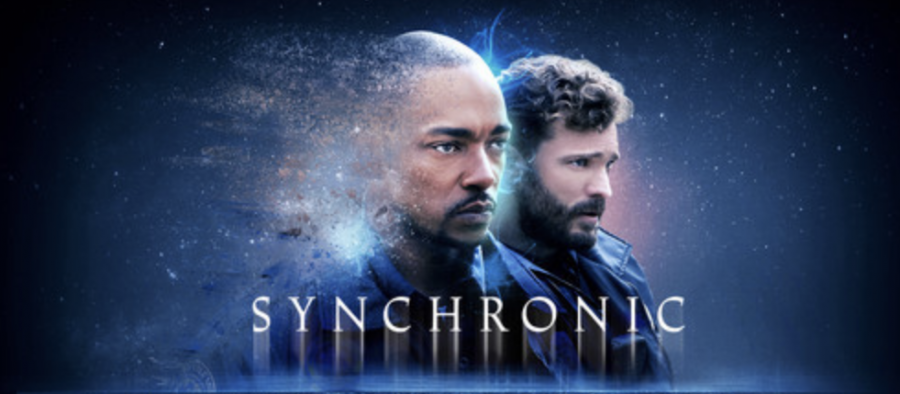The Underrated Sci-Fi Film, ‘Synchronic’, Takes a New Spin on Time Travel
CineMaterial
Synchronic is the latest mind-bending film available on Netflix. Photo courtesy of CineMaterial.
April 28, 2021
The film Synchronic, released in 2019, is one of those perplexing films that isn’t quite what you expect it to be. What you first believe is infinitely less fascinating than what is revealed. On the surface, this seems to be a cautionary tale of a drug abuse epidemic, in which a new, lethal recreational substance purified from a “rare red flower” enters the Louisiana state, killing large numbers of users. Although ordinary sci-fi movies deliver imagery of unimaginable substances with a wide myriad of drugs, the evil angle in this film portrays the horrific consequences. Director Aaron Moorhead offers a clever and suspenseful spin that is less about bending minds and more about bending physics.
The hints are planted systematically from the beginning. The opening scene starts off with a young woman coming up on a narcotic, dubbed “Synchronic”, in a hotel room and hallucinating the image of a Neanderthal with a snake attacking her. She is discovered just in time to be saved but is in a comatose state. Others are not as fortunate due to the drug’s ability to kill in a different and unique manner. The apparent stabbing of an addict is compounded by the discovery that the murder weapon is an ancient blade that has been extensively corroded, while another victim seems to have jumped down an elevator shaft.
Paramedics Steve, played by Anthony Mackie, and Dennis, played by Jamie Dornan, never know what to expect when they go into the deepest corners of New Orleans at dusk aside from the usual gang shootings, overdoses, and suicides. Heinous images that would torment other people for the rest of their lives are commonplace for the pair of first-responders. Both characters begin with no real ambition outside of their stressful jobs. With no real family, Steve’s days consist of one-night stands and bottles of booze. Dennis believes Steve has it all together with the ideology that it’s much easier to be independent and carefree than to be filled with obligations that could be avoided. Those attitudes change when Dennis realizes far too late that he is the one with a wonderful life, as he sees beyond the need for alcohol. Steve is ready to discover a larger meaning for himself, one that entails him to make a great sacrifice.
It’s not up to the spotlight duo to figure out what kind of hysteria the drug causes; they just assist those who need it and declare the less fortunate dead. When doctors discover a large, developing, and inoperable tumor in Steve’s brain, the story takes a turn. Despite the doctors’ claims that radiation will stave off the disease for a while, the difficult reality is that Steve is dying. With nothing to lose, he takes Synchronic himself and documents its amazing and potentially deadly consequences in a video diary.
Steve and Dennis are awakened late one night by yet another call. Dennis’ daughter, Brianna, has gone missing. Steve remains eager to figure out what happened to her and how Synchronic fits into the equation, even as he gets sicker from the one-two punch of his tumor and radiation therapy.
The film only really starts to take off when this psychedelic Trojan horse breaks open, allowing the true colors of the film to be revealed. Not only because of Mackie’s deadpan finesse in delivering Steve’s dry humor, but also because of the convincing unveiling of the buried dynamic plot and narrative structure. These not only have a few clever film references, but they make an important social point. As a Black man in America, Steve’s hallucinogenic experience is more of an exasperating nightmare than an adventure. Even though you are viewing everything as third-person, you still feel the character’s confusion in hectic, thought-provoking scenes. It’s not until an hour in that we understand certain effects of the mysterious drug, and even so, are still left with many questions. Through Steve’s video diaries and his analysis, we learn that the substance is in fact a time-traveling drug that lasts for exactly seven minutes.
The Synchronic drug isn’t merely mysterious, as it’s side effects can be described as gruesome. Violence is a major element throughout the film as evidenced by one scene where a man is seen lying on the pavement with a horrific stab wound through his chest. Cuts along his front and back are clearly visible even with the large amounts of blood. The properties of the drug lead us into some strange rabbit holes, such as one of the last scenes being composed of a trench littered with hundreds of war victim’s brutalized bodies. What begins as a grotesque horror film gradually transforms into the science fiction genre, making for an intriguing and inconsistent plot. The film seems to be obsessed with bloody, morbid scenes, and it constantly bombards the audience with foul language. We discover that Synchronic is a very risky substance, and that all of its participants pay the ultimate price for their high.
This clever indie sci-fi film has a lot to tell, incorporating some brilliant ideas rolled up in a creative drug concept that makes it seem even more intriguing than it already is. It’s one of those movies that is recommended to see as soon as possible before you are trapped in an engaging, long, and spoiler-filled discussion about how entertaining and thought-provoking it is.



